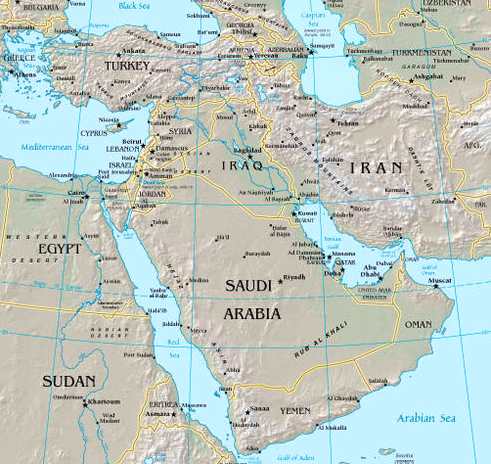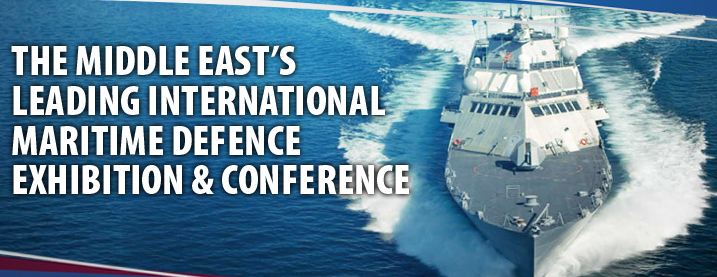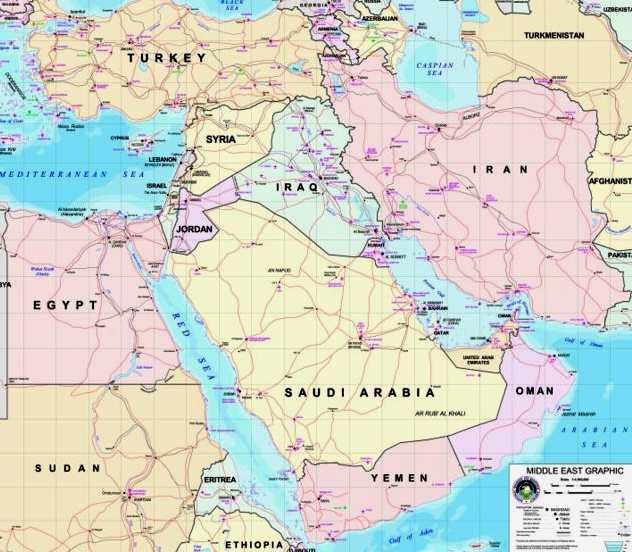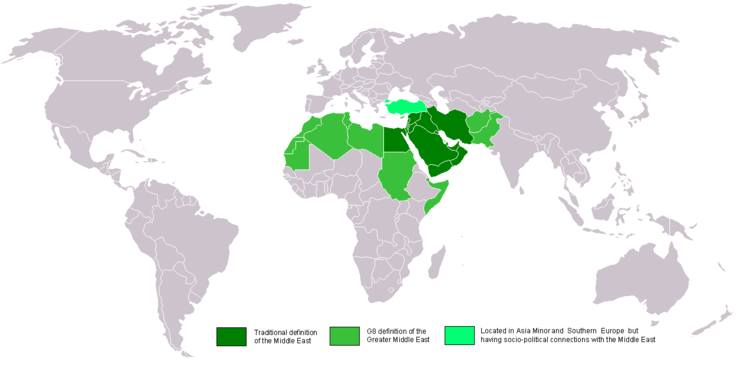|
THE MIDDLE EAST
Please use our A to Z INDEX to navigate this site
|
|||
|
The Middle East is a historical and geographical region of Africa-Eurasia with no clear definition; it traditionally includes countries or regions in Southwest Asia and parts of North Africa.
Many have criticized the term for a number of reasons, often due to its loose definition. The United Nations avoids the phrase entirely and officially refers to the region as "Southwest Asia," while other critics advise using the more general "West Asia"
Map showing countries commonly considered to be part of the Middle East - see world map below
Characteristics
The ethnic groups in the region may include Africans, Arabs, Assyrians, Armenians, Azeris, Berbers, Druze, Georgians, Greeks, Jews, Kurds, Maronites, Persians, Turks and Turkmen. Arabic in its numerous varieties is the most widely spoken language in the Arab countries ; other languages spoken in the region include Armenian, Assyrian (a form of Aramaic), Azeri,Berber languages,Georgian, Hebrew, Kurdish, Persian, Turkish, Greek, and Urdu. The corresponding adjective is Middle-Eastern and the derived noun is Middle-Easterner. Many Western definitions of the "Middle East" in both established reference books and common usage define the region as 'nations in Southwest Asia, from West Pakistan to Egypt.'
Egypt, with its Sinai Peninsula in Asia, is often considered part of the 'Middle East', although most of the country lies geographically in North Africa. North African nations without Asian links, such as Libya, Tunisia and Algeria, are increasingly being called North African as opposed to Middle Eastern (Pakistan to Egypt-Asia) by international media outlets. However, North African countries can also be considered part of the Middle East. Somalia, in the Horn of Africa, is also considered part of the "Greater Middle East".
One widely used definition of "Middle East" is that of the airline industry, maintained by the IATA standards organization. This definition as of early 2006 includes Afghanistan, Bahrain, Egypt, Iran, Iraq, Israel, Jordan, Kuwait, Lebanon, Palestinian territories (West Bank and Gaza strip), Oman, Qatar, Saudi Arabia, Sudan, Syrian Arab Republic, United Arab Emirates, and Yemen. This definition is used in world-wide airfare and tax calculations for passengers and cargo.
History
The Middle East (specifically, the Fertile Crescent) was one of the first centers of agriculture, and therefore of civilization. It lies at the juncture of Eurasia and Africa and of the Mediterranean Sea and the Indian Ocean. It is the birthplace and spiritual center of the Orthodox Christianity, Islam, Judaism, Yezidi, Iran: Mithraism, Zoroastrianism, Manichaeism, and Bahá'í Faith. The Garden of Eden was also thought to be located between the Tigris and the Euphrates rivers, making the Middle East the cradle of civilization, as God created the first man and the first woman in the Garden of Eden. Thus, throughout its history it has been a major center of world affairs; a strategically, economically, politically, culturally, and religiously sensitive area. Starting in the 20th century, its significant stocks of crude oil gave it new strategic and economic importance. The region has experienced both periods of relative peace and tolerance and periods of conflict and war. After the partitioning of the Ottoman Empire the modern Middle East was formed.
Geography
Middle East defines a geographical area, but does not have precise defined borders. The most common and highly arbitrary definition includes: Bahrain, Egypt, Iran, Iraq, Israel, Jordan, Kuwait, Lebanon, Oman, Qatar, Saudi Arabia, Syria, Turkey, the United Arab Emirates, Yemen, Palestinian Territories and western parts of Pakistan.
The inclusion of Iran, Pakistan and Turkey is often contentious as they are neither Arab states, nor located in the middle of the Arab world like Israel, which also has a significant Arab population. Iran is also the only Indo-European-speaking country out of all the above.
Other countries that are sometimes included in this definition are those of the Caucasus region (Azerbaijan, Armenia and Georgia), Greece and Cyprus, North Africa and the Maghreb. Like the situation of Iran, Pakistan and Turkey, the inclusion of these countries is controversial, and often more so because they are located far outside the arbitrary geographical boundaries of the Middle East.
Political & transportation map of the traditional Middle East
Changes in meaning over time
Until World War II, WW2, it was customary to refer to the eastern shore of the Mediterranean as the Near East. The Middle East then meant the area from Mesopotamia to Burma, namely the area between the Near East and the Far East. The sense described in this article evolved during the war, perhaps influenced by the ancient idea of the Mediterranean as the "sea in the middle".
Criticism and usage
Many have criticized the term Middle East for what they see as Eurocentrism, because it was originally coined by Europeans and reflects the geographical position of the region from a European perspective. It is also criticized due to the fact that the term today is often used to only refer to the Arab world, making the situation more confused.
Today the term is used by Europeans and non-Europeans alike, unlike the similar term Mashreq, used exclusively in Arabic-language contexts. The region is only east from the perspective of Europe. To an Indian, it lies to the west; to a Russian, it lies to the south. The description Middle has also led to some confusion over changing definitions. Before the First World War, Near East was used in English to refer to the Balkans and the Ottoman Empire, while Middle East referred to Persia, Kurdistan, Afghanistan, Pakistan and Central Asia, Turkistan and the Caucasus. In contrast, Far East refers to the countries of East Asia, e.g. China, Japan, Koreas, Hong Kong (China), Taiwan, etc. Such critics usually advise using an alternative term, such as "West Asia". The official UN designation of the area is "Southwest Asia".
With the disappearance of the Ottoman Turkish Empire in 1918, Near East largely fell out of common use in English, while Middle East came to be applied to the re-emerging countries of the Islamic world. However, the usage of Near East was retained by a variety of academic disciplines, including archaeology and ancient history, where it describes an area identical to the term Middle East, which is not used by these disciplines. So in shorter words, the term Middle East came about when the UK/French part of the world used the term. In German the term Naher Osten (Near East) is still in common use and in Russian Ближний Восток (Near East) remains as the only appropriate term for the region.
DOOMSDAY OPERATION GRAND SLAM - Disillusioned extremists in Iran, North Korea and Russia, have grown impatient waiting for their leaders to act decisively, having watched the Ukraine debacle of Vladimir Putin rebound to weaken their CRINK axis members. This despite Hamas launching against Israel and Houthi attacks on the Red Sea. All that had the effect of waking the sleeping giant: NATO.
They
hatch a plot to kidnap top politicians from the west to create confusion,
as a prelude to an all out cyber
nuclear first and second strike, having first stockpiled sufficient gold
and weapons reserves, and fallout bunkers for their cells, to be able to
stage a second wave of conventional attacks, to in effect, take over the
world after the nuclear holocaust they
have engineered. Including assassinating their jaded leaders: Xi
Jinping; Vladimir
Putin, Iranian Grand Ayatollah, Ali
Khamenei, and Kim
Jong Un, supreme leader of communist North
Korea.
Indirect translations
There are terms similar to Near East and Middle East in other European languages, but, since it is a relative description, the meanings depend on the country and are different from the English terms generally.
Middle East world location map
LINKS and REFERENCE
Solar Cola drinkers care about planet earth
.. Thirst for Life
(330ml Planet Earth can)
|
|||
|
This website is Copyright © 1999 & 2024 Max Energy Limited an educational charity working hard for world peace. The bird logos and names Solar Navigator, Blueplanet Ecostar and Utopia Tristar are trademarks. All rights reserved. All other trademarks are hereby acknowledged.
|





